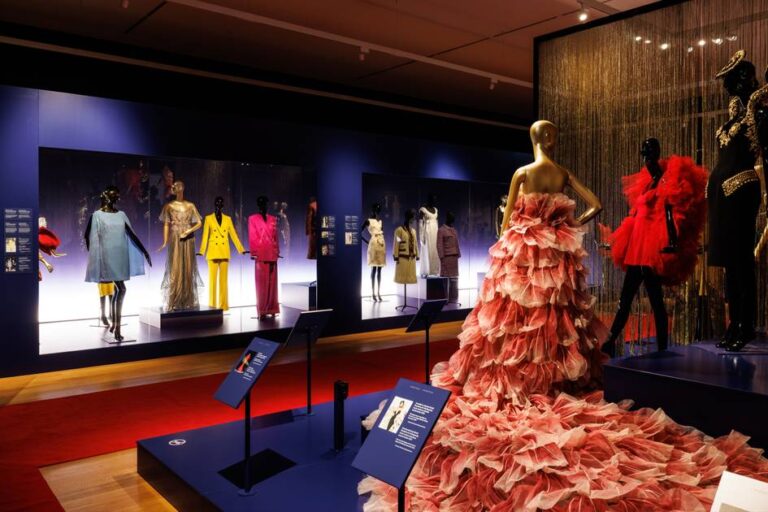After years of fantasizing, Paleis Het Loo and the Kunstmuseum The Hague are bringing together their most beautiful pieces in one stately exhibition: Dresscode. A clever theme, because what started as etiquette at court lives on today on the red carpet – and even on the street.
“The exhibition is not about the royal, but about coding,” says director of the palace, Frans van der Avert at the launch. “In the past you had a completely different coding, with morning, afternoon and evening dresses, and all kinds of liveries (distinctive uniforms) for the court. Now you can see from jewelry or tattoos whether people have a certain political color, or pursue a certain movement. Clothing tells you whether you want to belong to something or not, but then you belong to a different group. This is how the coding of fashion will always continue.”
The text continues below the image
The pitch came from curator Paul Rem, who wanted another major fashion exhibition in the palace (the last was in 2017, about Beatrix’s hats). “I thought: it’s still possible now. We have the stuff and the restorers – maybe they will soon disappear from the payroll. Let’s include the court clothes from the Art Museum, because that is the fashion collection of the Netherlands.” Putting together the exhibition became a kind of quartets. “I wish I had Queen Emma’s court train [1858-1934]then she had [curator Madelief Hohé] the maid of honor dress that resembled it. I am the museum guy of old collections and she has great relationships with modern fashion houses.”
What makes Dresscode so interesting, according to Rem, is that you see how fashion codes live on. “That a Lady Gaga or Salma Hayek is now wearing a dress that you can easily teleport to Paris in 1810. Such an actress probably doesn’t even realize that she is using the regal idiom.” He would also have liked to show the ‘Omelette Dress’ by Guo Pei, which Rihanna wore to the Met Gala in 2017, but that failed. “You have to be a queen to wear that,” says Rem. “Not as a reigning queen, but as a woman with power. It is not without reason that yellow is the imperial court color of the past. It was played with without Rihanna realizing it.”
The text continues below the image
What is the curator most proud of? “The court trains. Isn’t it insane that a law was issued in 1825: from now on all chic ladies appear with a train of so many meters – and a little less if they are less important? But I also enjoy it when I see three boys on the sports field on a Saturday morning in their dress code. They won’t call it that, but you can’t play football without a football shirt.”
The exhibition is full of refreshers about court life in the time of Queen Wilhelmina (1890–1948) and Juliana (1948–1980): who fulfilled what role, how the days passed, and what was worn. The dress codes were strict, specific and provided clarity. You wore white on the tennis court, but also after the loss of a loved one. Then you put on a white mourning cap: a hat with a veil as a symbol of belief in life after death. You rode horses in tightly woven tweed in camouflage colors, regardless of your gender. You even put on a ‘walking suit’ for a walk. Nowadays, a hoodie with sweatpants is sufficient.
The text continues below the image
Fans of the royal family can grab their bingo card in search of the wedding dresses of family members and unique pieces from the wardrobe of Queen Máxima (Claes Iversen and Jan Taminiau). More spectacular are Jacques Azagury’s five sequin dresses for Princess Diana. Van der Avert: “Those designs were selected for her public appearances and linked to revenge. She knew: I now have to impress with that dress. I have to radiate power. That is a different code than royal.”
Dress codes are also there to be broken. The exhibition features the types who dared to do so – yes, Lady Di, but also Queen Wilhelmina, who wore dresses in which her ankles were visible at gala events. Princess Juliana went one step further and showed off her calves. Lots of skin, but a train: this is how queens negotiated the fashion image with outspoken taste.
The visitor is also reminded that those gowns and skirt suits did not come off the assembly line. Until the early 1920s, all fashion – including that of the maid – was tailor-made and altered: if something broke, you went to the seamstress. Now there is a code for that again: anyone who takes good care of their clothes is a conscious consumer.
Only in the last room is the average wearer allowed to speak about what fashion means. People from different social groups made personal, distinctive outfits. (After all, we live in a time of ‘come as you are’). We see the Y2K costume of Linora (15) from the youth council in Apeldoorn, home of the palace. A loud look full of color and prints from Nichon (40), a sustainable fellow activist who has not bought new clothes for sixteen years. The gray sweater of filmmaker Sia (38), with the pontifical ‘Dolle Mina’ on it. What a treat that the codes have become so transparent, you might think. That someone can go out into the street in a hoodie, to be a Mina.
The Dresscode exhibition in Het Loo Palace is open to the public from October 9 to March 8, 2026.


